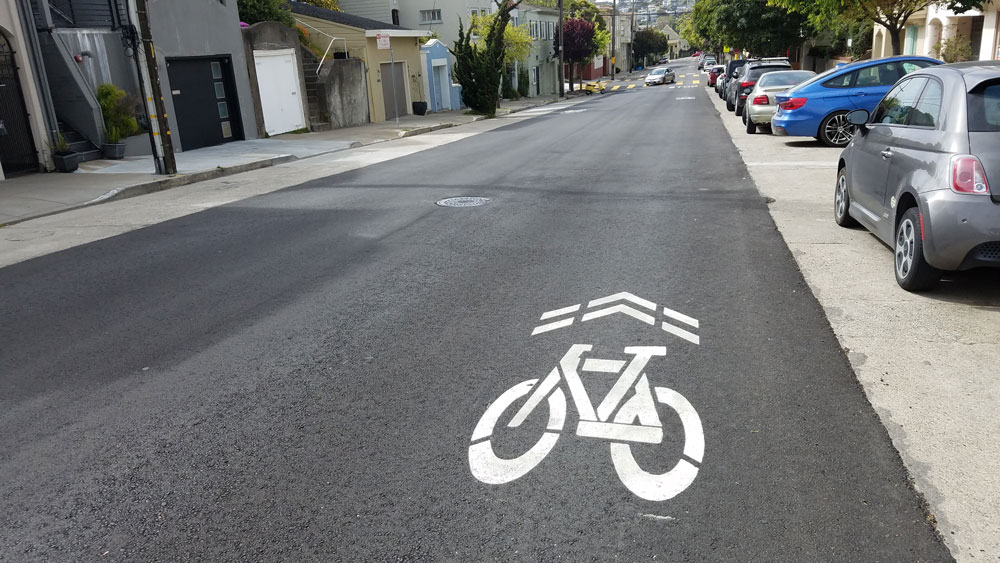Wheel Talk for Wheel People is a monthly advice column written by Christopher White, our adult education program coordinator. Though bikes, biking and getting around SF are our areas of expertise, feel free to ask anything! To submit your questions, please click here.
Wheel Talk, I am an experienced urban rider, but I still get unnerved when other riders pass me silently on my right. How do you feel about a gentle ‘on your right’ call-out, or would you suggest that riders always try to pass each other on the left? —Alright to the Right?
Dear Alright to the Right: None of us want to be told, “You’re so predictable!” Except, that is, when we’re riding our bikes. As I teach in our Bicycle Education classes, the best practice for keeping yourself safe on city streets is to ride predictably. When I offer this advice, I then ask class attendees what they think that means, and there are a number of great answers: obey the rules of the road, ride in a straight line, use hand signals (to name but a few). Following these predictable behaviors enables others to react safely and appropriately to your actions.
Passing another person on a bike to the right is the very definition of unpredictable behavior. As an experienced urban rider, you expect to be passed on the left. It happens all the time, and you know how to react to it. You don’t expect to be passed on the right, and therefore don’t know how to react. Move away from the person passing? But that will put you closer to vehicle traffic. Stay where you are? But that may feel like risking a collision, particularly because there likely isn’t the mandated three-foot buffer between you and the person passing. No wonder you’re unnerved! Additionally, unpredictable behavior is startling, and being startled can cause you to crash.
So my message is not to you, Alright to the Right; it’s to your fellow riders who are tempted to pass you or others to the right on city streets. Please don’t do it. It is unpredictable behavior that can endanger your fellow riders. And remember, passing anyone on a bicycle is only allowed (for people operating either motor vehicles or other bicycles) with three feet of clearance, which isn’t usually possible on the right. It may seem convenient; it may even look like you can squeeze through with no problem. But it’s not worth the risk. Pass to the left! (And do consider politely calling out the person you’re passing or ringing your bike bell.)
Wheel Talk, The new sharrows on Eureka seem to suggest I should be hugging the side of the road. When riding on sharrows, should I take the whole lane or ride so cars can easily pass? —Beware-O These Sharrows

The new sharrows on Eureka Street look especially close to parked cars, but that might be an illusion.
Dear Beware-O These Sharrows: Properly painted sharrows — which are, for the uninitiated, those insignias painted on shared streets depicting a bicycle topped by double arrows — should serve two purposes, one for each type of traveler sharing the street. For the person behind the wheel, they’re a reminder that people on bicycles use this street and are allowed to take up a full general traffic lane. For people on bikes, they should encourage us to ride straight down the center of the sharrow, and, in so doing, avoid the door zone. In other words, the sharrow should be painted so that the center of the sharrow is at least three feet away from any normally parked car.
The new sharrows you refer to do, at first glance, look a bit close to the parked cars. However, when I rode the street, I was definitely outside of the door zone when I rolled through the center of the sharrows. As you can see in the photo above, there are two unusual things about this newly paved street: there is no center line defining the lanes, and the pavement is particularly dark compared with the light grey concrete where cars are parked. I think that these details create the illusion that the sharrows are painted especially far to the right. From riding them, though, I think they’re painted correctly.
That being said, you are perfectly within your rights to take up any general traffic lane if that feels safest, regardless of the presence or placement of sharrows. If on Eureka you feel safest riding to the left of the sharrows’ centerline, do it!



